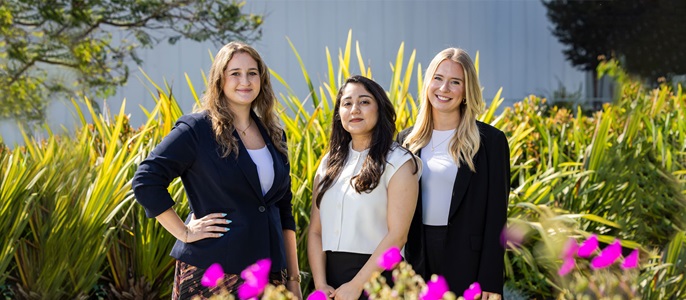Rosibel Diaz grew up loving puzzles, but never imagined that would lead to bonding mirrors on the James Webb Space Telescope (Webb).
Polar Partners
Hear from the team making this mission possible.

By Stephanie Bright and Caroline Mroz
Launched on Aug. 11, 2024, the Arctic Satellite Broadband Mission (ASBM) is a two-satellite constellation that will expand Arctic broadband coverage for the U.S. Space Force, Viasat, the Norwegian Armed Forces and Space Norway. Communications connectivity, particularly for U.S. and Norwegian forces operating in the remote region, is more critical than ever as the region becomes increasingly navigable for the U.S., our allies — and our adversaries.
The mission is a team effort, bringing together employees from across the company. Northrop Grumman provided the GEOStar-3 satellite bus and the commercial and military payloads for the mission — including Space Force's Enhanced Polar System-Recapitalization (EPS-R) payload, which is designed for secure U.S. military communications — as well as the Control and Planning Segment (CAPS) ground system which will support EPS-R.
Hear from the people making this mission possible.

Impact on the Ground
ASBM Ground Segment and Mission Operations Lead Kathryn Stewart has worked side-by-side with Space Norway, providing installation and training on operations and the ground command and control system. Her time in Norway provided an understanding of the customer's mission and impact on the region. She said the close coordination of the teams was instrumental to preparing for successful operations.
“Being on-site allowed me to work very closely with Space Norway and integrate their operational methods into our mission preparations," said Kathryn.

Up to the Task
Sanjukta Chowdhurry in Redondo Beach, California, leads the software integrated product team for EPS-R CAPS, which includes software, cyber security and infrastructure. She manages the schedule and execution, following Agile processes, creating dashboards and holding regular standups. Cybersecurity is a critical aspect of her role to protect mission data from potential threats.
“We faced lots of challenges, like obtaining the Authority to Operate," Sanjukta said. “Every team member rose to the challenge and delivered on time and schedule. There's great pride in seeing our hard work coming to fruition."

Raising His Hand
Systems Engineer Haili Cai didn't hesitate to temporarily relocate from Redondo Beach, California, to Dulles, Virginia, to support the EPS-R payload integration to the GEOStar-3 satellite. During two East Coast assignments — totaling 14 months away from home — he connected the dots between teams, leveraging relationships with new teammates and mentors from across the company. His advice to his colleagues: Seize opportunities.
“Take on the challenging task, the responsibility, and represent the team," said Haili, encouraging others to step outside their comfort zone like he did.

On the Road
Emmett Miller, EPS-R CAPS cyber security site lead at Schriever Space Force Base in Colorado Springs, Colorado, has traveled to three different parts of Norway. His team helped establish communication links and met with Space Norway, traveling extensively to Norway and Alaska to connect ground antennas to the satellite. Their combined miles averaged about 150,000 per year.
"Along the way, a lot of great people have contributed to ASBM's success," said Emmett. “It is great to know that we play an active role in our country's defense."

Keeping Things Interesting
Chi Wang, payload lead for ASBM's commercial payloads and the Norwegian Armed Forces’ payloads, enjoys the complexity of his work. During his 20-year Northrop Grumman career, Chi has thrived on programs requiring creative solutions. ASBM, which flies a unique orbit in a dynamic environment to achieve a critical mission, fits the bill.
“We saw the challenges during the design phase, and we all worked together to perform the analysis and discussion to solve these challenges," Chi said. “We look forward to seeing the on-orbit performance match the ground testing."

On the Fast Track
For Test Engineer Anna Bowman, the ASBM launch is made that much sweeter by experiencing firsthand the hard work that went into it.
Anna joined the EPS-R program in Redondo Beach, California, in 2022 after interning with Northrop Grumman in Baltimore, Maryland, for three consecutive summers during college. On her small and dynamic team, Anna wears many hats, from writing scripts to reviewing procedures to working on console during testing. Taking on these responsibilities early in her career has enabled her to make a big impact quickly.
“I was lucky to have a super supportive team and really good mentorship; I don't think I would have been able to step up in the way that I did without that support," said Anna. “It just makes it that much more meaningful to know the work that went into it when you see that payoff."
David Larter contributed to this article.
Life at Northrop Grumman
Your work at Northrop Grumman makes a difference. Whether you want to design next-generation aircraft, harness digital technologies or build spacecraft that will return humanity to the moon, you’ll contribute to technology that’s transforming the world. Check out our career opportunities to see how you can help define possible.


